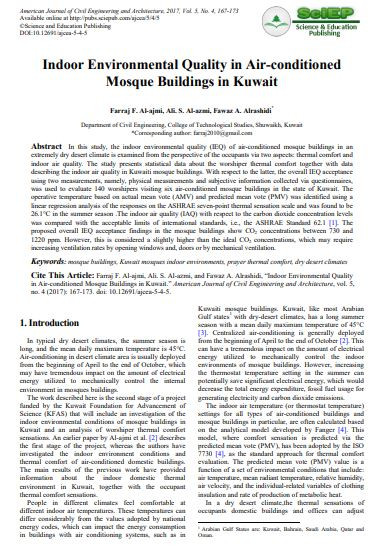
In this study, the indoor environmental quality (IEQ) of air-conditioned mosque buildings in an
extremely dry desert climate is examined from the perspective of the occupants via two aspects: thermal comfort and
indoor air quality. The study presents statistical data about the worshiper thermal comfort together with data
describing the indoor air quality in Kuwaiti mosque buildings. With respect to the latter, the overall IEQ acceptance
using two measurements, namely, physical measurements and subjective information collected via questionnaires,
was used to evaluate 140 worshipers visiting six air-conditioned mosque buildings in the state of Kuwait. The
operative temperature based on actual mean vote (AMV) and predicted mean vote (PMV) was identified using a
linear regression analysis of the responses on the ASHRAE seven-point thermal sensation scale and was found to be
26.1°C in the summer season .The indoor air quality (IAQ) with respect to the carbon dioxide concentration levels
was compared with the acceptable limits of international standards, i.e., the ASHRAE Standard 62.1 [1]. The
proposed overall IEQ acceptance findings in the mosque buildings show CO2 concentrations between 730 and
1220 ppm. However, this is considered a slightly higher than the ideal CO2 concentrations, which may require
increasing ventilation rates by opening windows and, doors or by mechanical ventilation.
I agree to the terms outlined below:
You agree to upload and assign Mosqpedia Database the rights to use the content worldwide and in perpetuity across all current and future media platforms. Mosqpedia Database may edit, copy, adapt and translate your contribution.
The content will be distributed under the Creative Commons Attribution-Deed – Attribution-NonCommercial-NoDerivatives 4.0 International – Creative Commons
All data will be stored in line with data protection regulations.